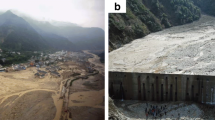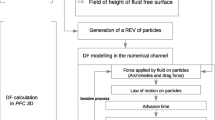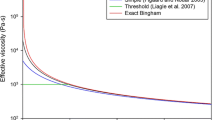Abstract
Extensive models used in debris flow runout simulations are two-dimensional with many limitations. Considering these limitations, a new three-dimensional computational fluid dynamics (CFD) code based on the finite difference method (FDM) was introduced to simulate debris flow runouts. The unique fractional area-volume obstacle representation (FAVOR), true-volume of fluid (Tru-VOF), and the renormalized group (RNG) model in the 3D CFD code were used to tackle mesh processing, free surface tracking, and turbulence, respectively. The RNG model has great performance in describing low-intensity flows and flows with strong shear regions. In addition, the 3D CFD modeling considers the vertical mobility of debris flow, which offers higher simulation accuracy compared to 2D approaches. Through simulating a case and a mesh size study, the accuracy of the model was validated and the optimal mesh size of Xiaojia Gully debris flow model was obtained, respectively. The affected areas, runout distances, deposition depths, and velocities of potential debris flows in Xiaojia Gully were acquired by adopting the present model. The simulation results show that debris flows with return periods of 50 years, 100 years, and 200 years will threaten the lives and safety of residents and their property in Xiaojia Gully. A sensitivity analysis was used to evaluate the influences of rheological parameters on this model, further verifying the rationality of the selected parameters. In general, the present model can scientifically and accurately simulate debris flows on irregular terrain and can be employed for similar risk management and engineering designs.















Similar content being viewed by others
References
Bao YD, Han XD, Chen JP, Zhang W, Zhan JW, Sun XH, Chen MH (2019a) Numerical assessment of failure potential of a large mine waste dump in Panzhihua City, China. Eng Geol 253:171–183
Bao YD, Chen JP, Sun XH, Han XD, Li YC, Zhang YW, Gu FF, Wang JQ (2019b) Debris flow prediction and prevention in reservoir area based on finite volume type shallow-water model: a case study of pumped-storage hydroelectric power station site in Yi County, Hebei China. Environ Earth Sci 78:577
Bisantino T, Fischer P, Gentile F, Liuzzi GT (2010) Rheological properties and debris-flow modeling in a southern Italy watershed. Monitoring, simulation, prevention and remediation of dense and debris flows III 67:237–248
Chang M, Tang C, Van Asch TWJ, Cai F (2017) Hazard assessment of debris flows in the Wenchuan earthquake-stricken area, south west China. Landslides 14:1783–1792
Chen HX, Zhang LM, Zhang S, Xiang B, Wang XF (2013) Hybrid simulation of the initiation and runout characteristics of a catastrophic debris flow. J Mt Sci 10:219–232
Chen HX, Zhang LM, Zhang S (2014) Evolution of debris flow properties and physical interactions in debris-flow mixtures in the Wenchuan earthquake zone. Eng Geol 182:136–147
Chen HX, Zhang LM, Gao L, Yuan Q, Lu T, Xiang B, Zhuang WL (2017) Simulation of interactions among multiple debris flows. Landslides 14:595–615
D’Agostino V, Tecca PR (2006) Some considerations on the application of the FLO-2D model for debris flow hazard assessment. Monitoring, simulation, prevention and remediation of dense and debris flows 90:159–170
Fei XJ, Shu AP (2004) Movement mechanism and disaster control for debris flow. Tsinghua University Press, Beijing (In Chinese)
Flow Science (2016) FLOW-3D V11.2 user’s manual. Flow Science Inc, Los Alamos
Fraccarollo L, Papa M (2000) Numerical simulation of real debris-flow events. Phys Chem Earth Part B 25(9):757–763
Gaulke D, Dreyer ME (2015) CFD simulation of capillary transport of liquid between parallel perforated plates using Flow3D. Microgravity Sci Technol 27:261–271
George DL, Iverson RM (2014) A depth-averaged debris-flow model that includes the effects of evolving dilatancy. II. Numerical predictions and experimental tests. Proceedings of The Royal Society A: Mathematical Physical and Engineering Sciences 470:20130820
Ghazizadeh F, Moghaddam MA (2016) An experimental and numerical comparison of flow hydraulic parameters in circular crested weir using Flow3D. Civil Eng J 2:23–37
Gregoretti C, Degetto M, Boreggio M (2016) GIS-based cell model for simulating debris flow runout on a fan. J Hydrol 534:326–340
Gresho PM (1991) Some current CFD issues relevant to the incompressible Navier-Stokes equations. Comput Methods Appl Mech Eng 87(2–3):201–252
Han XD, Chen JP, Xu PH, Niu CC, Zhan JW (2018) Runout analysis of a potential debris flow in the Dongwopu Gully based on a well-balanced numerical model over complex topography. Bull Eng Geol Env 77:679–689
Han XD, Chen JP, Xu PH, Zhan JW (2017) A well-balanced numerical scheme for debris flow run-out prediction in Xiaojia Gully considering different hydrological designs. Landslides 14:2105–2114
Heugenhauser S, Kaschnitz E, Schumacher P (2020) Development of an aluminum compound casting process-Experiments and numerical simulations. J Mater Process Technol 279
Hirt CW, Nichols BD (1981) Volume of fluid (VOF) method for the dynamics of free boundaries. J Comput Phys 39(1):201–225
Horton AJ, Hales TC, Ouyang C, Fan X (2019) Identifying post-earthquake debris flow hazard using massflow. Eng Geol 258
Huang Y, Zhang WJ, Xu Q, Xie P, Hao L (2011) Run-out analysis of flow-like landslides triggered by the Ms 8.0 2008 Wenchuan earthquake using smoothed particle hydrodynamics. Landslides 9:275–283
Hungr O, Evans SG, Bovis MJ, Hutchinson JN (2001) A review of the classification of landslides of the flow type. Environ Eng Geosci 7(3):221–238
Hu YX, Chen ML, Zhou JW (2019) Numerical simulation of the entrainment effect during mass movement in high-speed debris avalanches. Arabian J Geosci 12
Hu YX, Yu ZY, Zhou JW (2020) Numerical simulation of landslide-generated waves during the 11 October 2018 Baige landslide at the Jinsha River. Landslides 17:2317–2328
Iverson RM (1997) The physics of debris flows. Rev Geophys 35(3):245–296
Iverson RM, George DL (2014) A depth-averaged debris-flow model that includes the effects of evolving dilatancy. I. Physical basis. Proceedings of The Royal Society A: Mathematical Physical and Engineering Sciences 470:20130819
Kwan JSH, Sze EHY, Lam C (2019) Finite element analysis for rockfall and debris flow mitigation works1. Can Geotech J 56:1225–1250
Liu DZ, Cui YF, Guo J, Yu ZL, Chan D, Lei MY (2020) Investigating the effects of clay/sand content on depositional mechanisms of submarine debris flows through physical and numerical modeling. Landslides 17:1863–1880
Liu JF, Nakatani K, Mizuyama T (2013) Effect assessment of debris flow mitigation works based on numerical simulation by using Kanako 2D. Landslides 10:161–173
Liu JF, You Y, Chen XQ, Liu JK, Chen XZ (2014) Characteristics and hazard prediction of largescale debris flow of Xiaojia gully in Yingxiu town, Sichuan Province, China. Eng Geol 180:55–67
Li XY, Zhao JD (2018) A unified CFD-DEM approach for modeling of debris flow impacts on flexible barriers. Int J Numer Anal Meth Geomech 42(14):1643–1670
Li XY, Zhao JD, Kwan JSH (2020a) Assessing debris flow impact on flexible ring net barrier: a coupled CFD-DEM study. Comput Geotech 128:103850
Li YQ, Dong JY, Rui W (2020b) Numerical simulation for capillary driven flow in capsule-type vane tank with clearances under microgravity. Microgravity Sci Technol 32:321–329
Medina V, Hürlimann M, Bateman A (2008) Application of FLATModel, a 2D finite volume code, to debris flows in the northeastern part of the Iberian Peninsula. Landslides 5:127–142
Miguel A, Garcia B, Robert S, Brodkey JJ, Chalmers (1994) Computer simulations of the rupture of a gas bubble at a gas-liquid interface and its implications in animal cell damage. Chem Eng Sci 49:2301–2320
Movahedi A, Kavianpour MR, Aminoroayaie Yamini O (2018) Evaluation and modeling scouring and sedimentation around downstream of large dams. Environ Earth Sci 77:320
Ni HY, Zheng WM, Liu XL, Gao YC (2010) Fractal-statistical analysis of grain-size distributions of debris-flow deposits and its geological implications. Landslides 8:253–259
O’Brien (2009) FLO-2D Users Manual Version 2009[R]. 10
O’Brien JS, Julien PY (1988) Laboratory analysis of mudflow properties. J Hydraul Eng 114(8):877–887
O’Brien JS, Julien PY, Fullerton WT (1993) Two-dimensional water flood and mudflow simulation. J Hydraul Eng 119(2):244–261
Ouyang CJ, He SM, Tang C (2015) Numerical analysis of dynamics of debris flow over erodible beds in Wenchuan earthquake-induced area. Eng Geol 194:62–72
Pellegrino AM, Schippa L (2018) A laboratory experience on the effect of grains concentration and coarse sediment on the rheology of natural debris-flows. Environ Earth Sci 77:749
Rickenmann D, Laigle D, Mcardell BW, Hübl J (2006) Comparison of 2D debris-flow simulation models with field events. Comput Geosci 10(2):241–264
Schippa L, Pavan S (2011) Numerical modelling of catastrophic events produced by mud or debris flows. Int J Saf Secur Eng 1(4):403–423
Schippa L (2020) Modeling the effect of sediment concentration on the flow-like behavior of natural debris flow. Int J Sedim Res 35:315–327
Specification for Geological Investigation of Debris Flow Stabilization (DZ/T0220–2006) (2006) Published by the Ministry of Natural Resources of the People's Republic of China
Takahashi T (2014) Debris flow: mechanics, prediction and countermeasures, 2nd edn. CRC Press, London
The Calculation Manual of Rainstorm and Flood in Small and Medium Basins of Sichuan Province (1984) Compiled by Sichuan Provincial Water Resources and Electric Power Department
Yakhot V, Orszag SA (1986) Renormalization group analysis of turbulence I. Basic theory. J Sci Comput 1(1):3–51
Yin YP, Huang BL, Chen XT, Liu GN, Wang SC (2015) Numerical analysis on wave generated by the Qianjiangping landslide in Three Gorges Reservoir, China. Landslides 12:355–364
Yusuf F, Micovic Z (2020) Prototype-scale investigation of spillway cavitation damage and numerical modeling of mitigation options. J Hydraul Eng 146(2):04019057
Zhang P, Ma JZ, Shu HP, Han T, Zhang YL (2014) Simulating debris flow deposition using a two-dimensional finite model and soil conservation service-curve number approach for Hanlin gully of southern Gansu (China). Environ Earth Sci 73(10):6417–6426
Zhao JD, Shan T (2013) Coupled CFD-DEM simulation of fluid-particle interaction in geomechanics. Powder Technol 239:248–258
Zhao YF, Koizumi Y, Aoyagi K, Yamanaka K, Chiba A (2020) Isothermal γ → ε phase transformation behavior in a Co-Cr-Mo alloy depending on thermal history during electron beam powder-bed additive manufacturing. J Mater Sci Technol 50:162–170
Zhuang Y, Yin YP, Xing AG, Jin KP (2020) Combined numerical investigation of the Yigong rock slide-debris avalanche and subsequent dam-break flood propagation in Tibet, China. Landslides 17:2217–2229
Acknowledgements
The authors would like to thank the CFD software FLOW-3D which provides a good platform for us to investigate the numerical simulation of debris flow runout. The authors would like to thank the editor and anonymous reviewers for their comments and suggestions which helped a lot in making this paper better.
Funding
This work was supported by the National Natural Science of China (Grant No. U1702241, 41941017) and the National Key Research and Development Plan (Grant No. 2018YFC1505301).
Author information
Authors and Affiliations
Corresponding author
Ethics declarations
Conflict of interest
The authors declare no competing interests.
Rights and permissions
About this article
Cite this article
Zhang, Y., Chen, J., Tan, C. et al. A novel approach to simulating debris flow runout via a three-dimensional CFD code: a case study of Xiaojia Gully. Bull Eng Geol Environ 80, 5293–5313 (2021). https://doi.org/10.1007/s10064-021-02270-x
Received:
Accepted:
Published:
Issue Date:
DOI: https://doi.org/10.1007/s10064-021-02270-x




